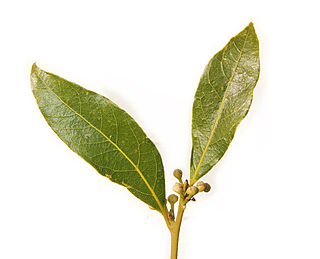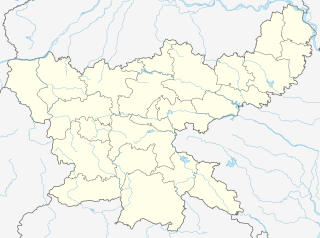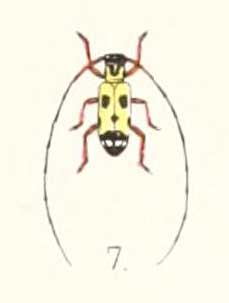
The Bay leaf is an aromatic leaf commonly used in cooking. It can be used whole, or as dried and ground.

Laurus nobilis is an aromatic evergreen tree or large shrub with green, glabrous leaves, in the flowering plant family Lauraceae. It is native to the Mediterranean region and is used as bay leaf for seasoning in cooking. Its common names include bay tree, bay laurel, sweet bay, true laurel, Grecian laurel, or simply laurel. Laurus nobilis figures prominently in classical Greco-Roman culture.

Nobilis is a contemporary fantasy role-playing game created by Jenna K. Moran, writing under the name R. Sean Borgstrom. The player characters are "Sovereign Powers" called the Nobilis; each Noble is the personification of an abstract concept or class of things such as Time, Death, cars, or communication. Unlike most role-playing games, Nobilis does not use dice or other random elements to determine the outcome of characters' actions, but instead uses a point-based system for task resolution.

Roberto de Nobili was an Italian Jesuit missionary to Southern India. He used a novel method of adaptation (accommodatio) to preach Christianity, adopting many local customs of India which were, in his view, not contrary to Christianity.
John Nobili, born Giovanni Pietro Antonio Nobili, (S.J.) was an Italian priest of the Society of Jesus. He was a missionary in the Oregon Territory and later founded Santa Clara College in California, United States.

Steatoda nobilis is a spider in the genus Steatoda, known in the United Kingdom as the noble false widow and often referred to as the false widow. As the common name indicates, the spider superficially resembles and is frequently confused for the black widow and other spiders in the genus Latrodectus, which can have medically significant venom. Steatoda nobilis is native to Madeira and the Canary Islands from where it allegedly spread to Europe, and arrived in England before 1879, perhaps through cargo sent to Torquay. In England it has a reputation as one of the few local spider species which is capable of inflicting a painful bite to humans, with most bites resulting in symptoms similar to a bee or wasp sting. It has also been found in California and Chile.

Chirkunda is a city and a notified area in Dhanbad district in the state of Jharkhand, India.

Costa de' Nobili is a comune (municipality) in the Province of Pavia in the Italian region Lombardy, located about 40 km southeast of Milan and about 20 km southeast of Pavia.

Banksia nobilis, commonly known as the golden dryandra, great dryandra or kerosene bush, is a shrub of the family Proteaceae which is endemic to Western Australia. It occurs on lateritic rises from Eneabba to Katanning in the state's Southwest Botanic Province. With large pinnatifid leaves with triangular lobes, and a golden or reddish pink inflorescence, it is a popular garden plant. It was known as Dryandra nobilis until 2007, when all Dryandra species were transferred to Banksia by Austin Mast and Kevin Thiele. There are two subspecies, B. nobilis subsp. nobilis and B. nobilis subsp. fragrans.

Hepatica nobilis, liverleaf, is a small herbaceous perennial in the buttercup family. It is native to the eastern United States and to central and eastern Canada.
The Gran Premio Nobili Rubinetterie is a single-day road bicycle race held annually in Arona, Italy. Since 2005, the race has been organised as a 1.1 event on the UCI Europe Tour. In 2010 the GP was split in two challenges, Coppa Papà Carlo and Coppa Città di Stresa, but reverted to a single race – on the route of the Coppa Città di Stresa – in 2012.
Tragocephalini is a tribe of longhorn beetles of the Lamiinae subfamily. It was described by Thomson in 1857.

Pseudochariesthes is a genus of longhorn beetles of the subfamily Lamiinae, containing the following species:

De Nobili School, CMRI, associated with the former Central Mining Research Institute in Dhanbad, Jharkhand, India, has classes one through twelve and is run by the Society of Jesus.
Isochariesthes lesnei is a species of beetle in the family Cerambycidae. It was described by Stephan von Breuning in 1934, originally under the genus Pseudochariesthes.

Isochariesthes breuningstefi is a species of beetle in the family Cerambycidae. It was described by Pierre Téocchi in 1985, originally under the genus Pseudochariesthes.
Isochariesthes multiguttata is a species of beetle in the family Cerambycidae. It was described by Hunt and Stephan von Breuning in 1955, originally under the genus Pseudochariesthes. It is known from Swaziland and South Africa. It measures between 7 to 7.5 mm.
Pseudochariesthes nigroguttata is a species of beetle in the family Cerambycidae. It was described by Per Olof Christopher Aurivillius in 1908. It contains the varietas Pseudochariesthes nigroguttata var. blairi.
Pseudochariesthes plena is a species of beetle in the family Cerambycidae. It was described by Jordan in 1903.
Pseudochariesthes superba is a species of beetle in the family Cerambycidae. It was described by Stephan von Breuning in 1962.












